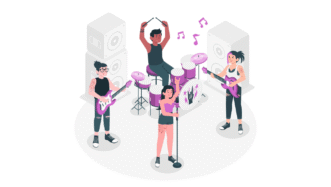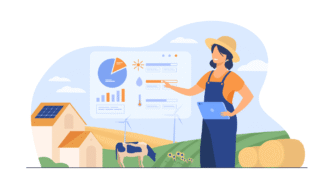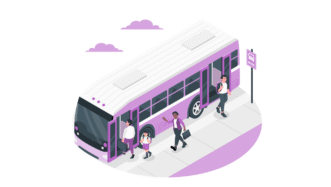LESSON OVERVIEW
In this ESL lesson about ChatGPT, students watch a video about schools banning the chat. They also learn vocabulary related to cheating and discuss different applications of ChatGPT.
VOCABULARY
In the first task of this ESL lesson about ChatGPT, students look at some tips and decide what the tips are for. The tips refer to different methods of cheating in exams. Students also briefly discuss their experience with cheating in exams. Then, they read two texts which present two perspectives on technology in education. They need to decide whose perspectives those are. The texts contain vocabulary related to cheating (e.g. be caught red-handed, mislead, plagiarize, integrity). After reading, students choose the correct definitions for the words and phrases in the text. They also finish some statements to present and explain their opinions regarding cheating in exams and punishing students for it.
VIDEO & SPEAKING
Before watching the video, students read a short introduction to ChatGPT and decide if they agree with some statements about using AI software. Then, they watch the video and take notes on three points listed in the task. After viewing, they share their thoughts about banning ChatGPT in schools. Students also read a list of tasks Chat GPT can do and discuss some questions. They need to say what they would use it for and predict how Chat GPT might change the way we work. The teacher can choose to show students ChatGPT and ask them to play around with it a bit. In the final part of this ESL lesson about ChatGPT, students read a case of a teacher who used ChatGPT with her students. There are several questions about the task that students need to answer.
HOMEWORK/REVISION
This ESL lesson about ChatGPT also includes an additional task to practise the vocabulary from the lesson. You can use it as homework or revision. It’s available in the teacher’s version of the worksheet. You can print it, cut it up and hand it out to your students. It’s also included in the e-lesson plan, if you teach online.
Subscribe to unlock these and many other Standalone lesson with the Premium planWORKSHEETS













Yay! I have been waiting for this topic :). Will see how it goes in the classroom. Thank you!
So great to see a lesson on this thank you! I’m from the UK and I’ve never heard the expression ‘cop to (doing) something’ before. We’d more likely say ‘own up to (doing) something’. Where does the writer of this lesson come from? Is it a regional expression? Or US English? It would be helpful to let students know! Thanks, Anna
Hi Anna! Thank you so much for your comment 🙂 This phrase does come from US English and one of the reasons we decided to focus students’ attention on it is that it’s used in the video [00:53].
Great lesson! More like this one, please!
Thank you for your feedback, Veronica! We’re happy you liked this lesson. We would appreciate it if you specified what exactly you mean by “like this one” so we can take your ideas into consideration 🙂
Hi Inna,
I have the same suggestions. Current topics related to AI or other fields are quite interesting for students to learn. Thanks
Thank you, Nancy!
Great lesson, very topical!
It is impossible to make a copy of this presentation
When you open the e-lesson plan, click File (in the top-left) > Make a copy > Entire presentation
Can we do more lessons aimed at Kids
Osbaldo, we don’t create lessons for kids or teens (and don’t plan to change that anytime soon). Our materials are designed with adult learners in mind.
A very good and current discussion topic. I particularly liked how the lesson explained the new words in English. In my country, it is a big issue in schools. The more articles I read about it, my opinion becomes more complex.
Thank you so much for your feedback! We’re happy you liked this lesson plan 🙂
Great lesson! Thank you!
Thank you so much!
Wow! thank you for this hot potato! Loving it:)
We’re happy you liked it 🙂 Thank you!
A fantastic lesson, and very popular with my students. So popular that when they hear about chargpt in the news they send me they often send me messages about it.
To make it more suitable for B2 level, I would modify the video task to include both a General Understanding and a Detailed Undetstanding task. Likewise for C1 levels, I skip excerises 2-4. I also don’t bother teaching “cop to” bcs the context is verty clear in the video and I don’t want to overburden my students with unnecessary vocabulary.
Having said that, this has probably been one of the most popular lessons that I have taken from this site and used with my students. So thank you again and keep up the good work!
Thank you so much for your feedback, Alex! It’s wonderful to hear how you adjust our materials to cater for your students’ needs 🙂
I’m trying to play the video but it’s saying:
Video unavailable
The uploader has not made this video available in your country
I’m in Canada. Can you please make it available?
Unfortunately, it seems that CNBS YT channel might be limited for Canadians. Is anyone else outside Canada experiencing such a video issue?
Hi, first of all – an interesting topic. I’ve planned to do this with one of my students who’s a retired computer teacher and she’s looking forward to it!
Just a quick question – above, it mentions that ‘this ESL lesson about ChatGPT also includes an additional task to practise reflexive pronouns’. I can find an additional task, which is indeed interesting, but not the reflexive pronoun one . . . or am I missing something?
Hi! The additional task is actually to practise the vocabulary from the lesson. That was our mistake, sorry! It’s fixed now.
Hope your student likes the lesson 🙂
Video unfortunately not available in Australia
Hi! You can also watch the video here. Alternatively, you could use a VPN.